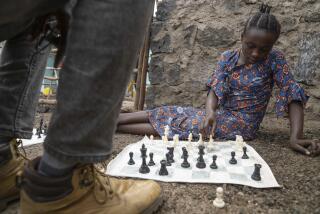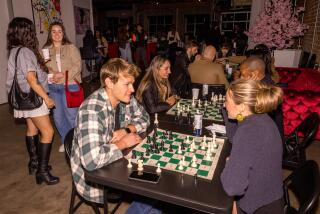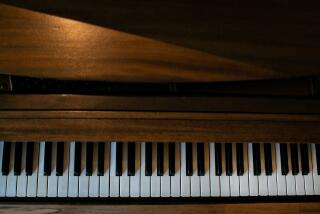No Longer a Pawn : The game of chess may be an acquired taste, but it’s also surprisingly addictive--especially once you know what to call the pieces.
- Share via
WOODLAND HILLS — “Chess is more than just a game,” instructor David Esser started. “It’s an art. It’s a science, and most of all it’s the most misunderstood religious experience. If you spend so much time in the game, you will find so much beauty that tears will come to your eyes.”
I wasn’t sure what to say. No response seemed adequate. Certainly what I was thinking, which was “I have the attention span of a gnat,” wasn’t appropriate.
Esser was about to introduce me to the wonders of chess, wonders that would expand my mind, make me brighter, make my brain more dense.
I had come to Gym for the Mind in Woodland Hills to learn a game in which I had little interest and absolutely no knowledge.
My husband had once tried to teach me the basics on a huge chessboard with four-foot-high pieces. But the timing was off. We were in Jamaica. On our honeymoon.
When I walked into Gym for the Mind, I still called the pieces the Horse, the Pointy Thing, the Castle, the Little Round-Headed Pieces and the Two in the Middle.
“When I teach chess, I teach everything that goes with it,” Esser told me as we sat in the den-like gym, named in part for the weight machines behind the book-lined game room.
“I teach everyone like an 8-year-old,” Esser continued. “Maybe because I’ve been teaching 8-year-olds for 20 years.”
First, Esser taught me the pieces’ names and movements. For example, the horse is really a knight. And he moves in an L-shape and can jump over other pieces to get where he is going. Kind of like a horse. So, I remember things like an 8-year-old.
The little round-headed things are pawns. OK, this much I knew. They march straight ahead, unless they are killing another piece, and then they move diagonally. I realize that killing isn’t the proper term here. But it makes it a little more exciting. Call it the Quentin Tarantino version of chess.
The king, the liability in the game, can move in any direction but only one square at a time. “I tell the kids to remember the king as being an old man who can only go one square and has to stop and rest,” Esser said.
And the queen, well the queen can move anywhere she wants. “The queen is the most powerful piece in the game,” Esser said. Hmm. I’m starting to like this game, I thought.
We played a short game. I lost. I know this must come as a great shock.
“I think chess is very valuable to our society,” Esser explained as I stared at the board, wishing one of my men would wave to me and point to where he wanted to go.
“Less than one-tenth of 1% of people are actually playing chess,” Esser continued. “It’s really an acquired taste.”
I was surprised. I was starting to acquire it.
The second lesson in my series of three started with a discussion of the book “Frames of Mind: The Theory of Multiple Intelligences” by Howard Gardner. Gardner theorizes about the different intelligences--linguistic, musical, bodily-kinetic, philosophical and, the ones relating to chess, spatial and logical-mathematical.
“That’s your chess,” Esser said of the logical-mathematical entry.
I had been feeling pretty confident until then. But mathematical intelligence? The only thing I remember about high school trigonometry is two neckties the teacher wore. One had an apple on it, the other a mermaid.
That is the sum of my higher mathematical training. In college I took logic to gain math credits. And I took it pass-fail.
I didn’t tell any of this to Esser, who was showing me the two chess universes, the open game and the closed game. We talked about stages and strategies of chess. And he gave me homework. He told me to play 10 games and lose gracefully.
So I borrowed a board and pieces and took them home to a surprised husband.
I lost four games. But only three gracefully. The first game, I took his queen. But this would not be repeated. Remember the thing about mathematical intelligence? Well, my husband started college as a physics major.
Still, capturing the queen was a thrilling, if temporary victory. I could cheerfully lose the next few rounds.
“The only way to learn chess is through failure and the act of trying,” Esser said at our final lesson. “That’s why so many people don’t want to learn the game--because so few people want to experience failure.”
I had to agree. I liked the game, but I wanted to kick some butt--spousal butt.
Esser understood. He taught me weaponry--double attacks, removing the guard, the pin, checkmate patterns. But he also stressed that chess isn’t just about winning and losing. The game is also about relieving stress, using your brain, becoming more well-rounded, he said.
I was hooked. I couldn’t believe I understood--and enjoyed--the game. But I had joined the one-tenth of 1% who would actually sit down at a table and play. So I wrote a check for the set I had borrowed and set off on my journey of failure and trying.
At home, our kitchen table became the chess table. Breakfasts became tournament time. And during one of our games, I had what Esser calls the “Uh-huh! experience.”
I’m still not sure how it happened, but I was trying to fend off my husband’s attacking pieces when I looked up and my rook had a straight shot at his king. Checkmate. Uh-huh!
I wouldn’t say tears came to my eyes, but I must admit a little jig sprang to my feet.
(BEGIN TEXT OF INFOBOX / INFOGRAPHIC)
WHERE TO GO
What: Chess lessons at Gym for the Mind.
Location: 4907 Topanga Canyon Blvd., Woodland Hills.
Price: $50 for three introductory lessons.
Call: (818) 710-8042.


